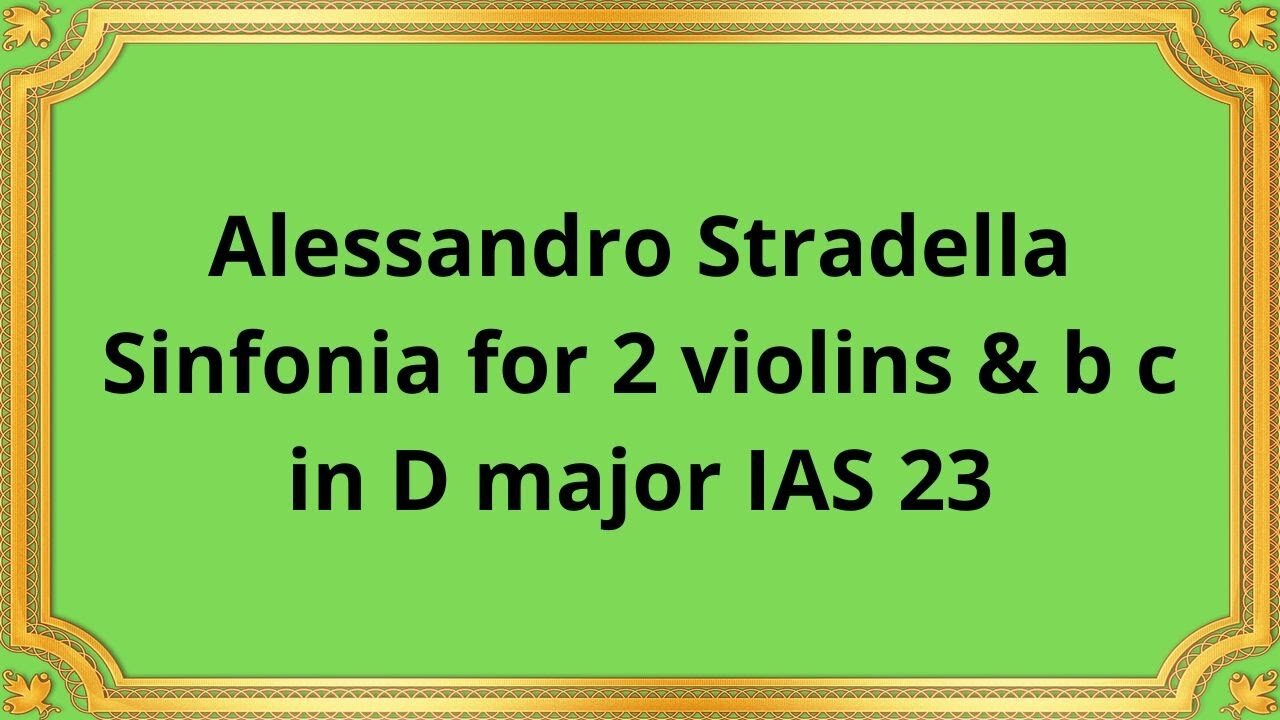Premium Only Content

Alessandro Stradella Sinfonia for 2 violins & b c in D major IAS 23
#AlessandroStradella #Sinfonia #2Violins #BassoContinuo #DMajor #IAS23 #ClassicalMusic #MusicalComposition #BaroqueEra #ItalianComposer #InstrumentalMusic
Publication date 1954
Trio di Bolzano
Nunzio Montanari (piano)
Giannino Carpi (violin)
Antonio Valisi (’cello)
Alessandro Stradella, a prominent Italian composer of the Baroque era, has left an indelible mark on the world of classical music. His Sinfonia for 2 Violins & Basso Continuo in D Major (IAS 23) stands as a testament to his exceptional compositional skill and musical genius.
Composed during the Baroque era, a period known for its ornate and intricate musical style, Stradella's Sinfonia showcases the essence of this period. As an Italian composer, Stradella played a significant role in shaping the musical landscape of his time, and this composition exemplifies his mastery in crafting engaging and expressive instrumental music.
The Sinfonia for 2 Violins & Basso Continuo in D Major is a delightful composition that exemplifies Stradella's ability to weave together the voices of two violins and the basso continuo in a harmonious and captivating manner.
1. Introduction:
The sinfonia opens with a vibrant and engaging introduction, setting the stage for the entire piece. Stradella's use of lively melodies and rich harmonies immediately captures the listener's attention, drawing them into the world of the composition.
2. Allegro:
The first movement, marked Allegro, exudes energy and vitality. The two violins engage in a spirited conversation, showcasing their technical brilliance and virtuosity. Stradella's masterful use of counterpoint and dynamic interplay between the instruments creates a sense of musical dialogue and excitement.
3. Adagio:
Following the exuberance of the Allegro, the Adagio movement provides a contrasting and introspective moment within the sinfonia. The violins take turns expressing poignant and lyrical melodies, accompanied by the gentle harmonies of the basso continuo. Stradella's use of expressive ornamentation and harmonic depth evokes a sense of emotional introspection and beauty.
4. Allegro finale:
The final movement, marked Allegro, brings the sinfonia to a thrilling conclusion. Stradella's use of lively rhythms and intricate melodic variations showcases the technical prowess of the violins. The movement combines elements of dance-like motifs with virtuosic passages, creating a sense of exhilaration and anticipation.
Stradella's Sinfonia for 2 Violins & Basso Continuo in D Major (IAS 23) has had a profound impact on the world of instrumental music. Its technical brilliance, expressive melodies, and seamless interplay between the violins and basso continuo have influenced subsequent composers and performers. Stradella's ability to create a harmonious and engaging dialogue between the instruments has made this sinfonia a cherished addition to the repertoire of Baroque chamber music.
Conclusion:
Alessandro Stradella's Sinfonia for 2 Violins & Basso Continuo in D Major (IAS 23) stands as a testament to the composer's mastery of Baroque instrumental music. Through its vibrant musical structure, the composition exemplifies Stradella's ability to create engaging and expressive dialogues between the violins and basso continuo, evoking a range of emotions within the listener. As we continue to appreciate and explore this remarkable work, we gain a deeper understanding of Stradella's significant contribution to the rich tapestry of classical music.
You have the opportunity to support the channel:
https://destream.net/live/RadSiarAl/donate
https://www.buymeacoffee.com/6355radsiaral
-
 31:06
31:06
Classical music_Music Inspiration
17 days agoPyotr Ilyich Tchaikovsky Piano Concerto No. 1 in B-flat minor
511 -
 5:41
5:41
Blackstone Griddles
11 hours agoChicken Fettuccine on the Blackstone Griddle
3211 -
 1:06:02
1:06:02
Nicholas Bowling
11 hours agoStreet Preaching at VIOLENT Gay Pride Festival!
82 -
 27:43
27:43
Stephen Gardner
10 hours ago🔥OMG, HE DID IT! + Melania Trump’s UNEXPECTED Move!
8.56K55 -
 10:17
10:17
Nikko Ortiz
15 hours agoMilitary TikToks Better Than Therapy
52.2K3 -
 16:59
16:59
Zoufry
1 day agoHow an FBI Agent Infiltrated The US Most Secretive Biker Gang
13.6K6 -
 51:05
51:05
SGT Report
10 hours agoHIGH STAKES TREASON -- Ian Trottier
13.1K9 -
 UPCOMING
UPCOMING
BEK TV
21 hours agoTrent Loos in the Morning - 8/19/2025
72 -
 9:49
9:49
The Shannon Joy Show
12 hours ago🔥HHS Gaslights the Dead: Bhattacharya Abandons Vaccine-Injured🔥
7611 -
 1:55:54
1:55:54
Investigate Everything w/ Brian O'Shea
11 hours agoEP250818 Deep Cover: Interview with Undercover Reporter Alicia Powe
1.01K